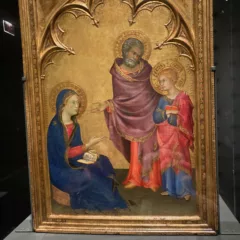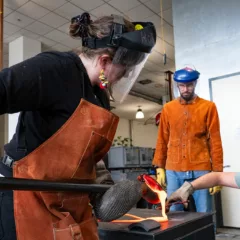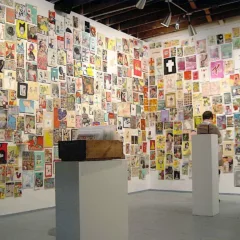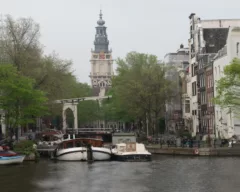Peter Schuyff, the Dutch-born painter who became deeply associated with the painting explosion in New York as part of the Neo-Geo artists, always had a knack for the visual hook. Like a pop song, his self-portraits, drawings on old drawings, paintings on found paintings, and intricately carved pencils and baseball bats, produce a kind of mind-body harmony with all the structure of musical rhythm and melody. Yes, it’s an odd thing to compare visual to musical art, but in the case of Schuyff’s visual works, music is an appropriate underpinning.
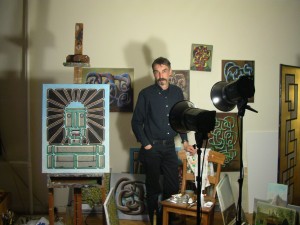
I first met Peter a decade ago thanks to Keith Donovan (more on him in another article) – a painter born in Canada, who has long lived in France. Peter was wiry, but gentle. His reputation was fairly large : a New York art star aligned with ’80s masters like Philip Taaffe among others for a kind of surrealistic and seductive “wallpaper.” I visited Peter in New York at his Chelsea Hotel studio in February 2002, where, after we discussed the 9/11 attacks (“New York is the biggest party on the planet, we had to have the biggest explosion, too,” he said to me), he showed me his collection of Ray Johnson collages, one of best collections I’d seen.
When I met with Peter at his studio in Amsterdam it was evident that music is completely integrated into his life. He’d just returned from a live performance of material from his album, The Woodwards (also Peter’s alter-ego), on Holland’s national radio network. “I’ve always said that the music [pieces] are the paintings I’ve always wanted to make,” he told me. I was treated to a number of songs by Peter and his companion, musician and singer, Signe Tollefsen.
For more visuals by Peter Schuyff visit his web site. Music: The Woodwards are here. Gallery: See Nicole Klagsbrun for current works by Peter.
1. You left your Chelsea Hotel studio some years ago to return to Holland, and set up a studio in Amsterdam. What provoked the move and how has it changed the way you work?
I left New York in 2003 and went to Vancouver. I didn’t like that very much. I have some great friends and colleagues there but (I) smoke drink and swear too much for Vancouver. Amsterdam is a perfect place for me. I work well, especially on paintings over found paintings (easier to find here); almost all of my social life here is dedicated to The Woodwards, so my paintings are left alone to their own devices.
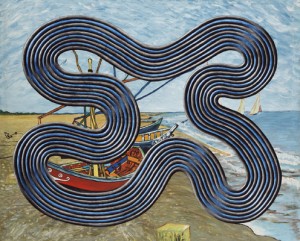
2. Your paintings have evolved slowly but surely over the past 10 years with more and more emphasis in optical illusion. I’m thinking of the brightly-colored, mind-blowing paintings with their tight-knit structures, tight shadows and somewhat mystical subjects. There is still a kind of geometric essence to these works. Can you elaborate about how this group of works evolved and where you’re heading with them?
What’s this optical illusion stuff? They are no more illusions than anyone describing a shape with light. If anything, the paintings from the late 1980s involved illusions. Now I paint much like any classical painter. The work seems to be getting more intimate. And the most recent shapes are almost narrative. I’ve always envied painters who can tell stories and I suppose these come as close as I’ve been able to get to tell a story. I think I got some wind in that sail from writing and singing songs. I’ve said that the music is the paintings I’ve always wanted to make.
3. I saw the carved pencils and totems in New York at Bill Maynes Gallery in 2002, and noticed in your studio in Amsterdam the carved totemic baseball bats. An ode to Cooperstown? Can you talk about how these works came into being? I’m also curious as to what the Dutch make of the bats.
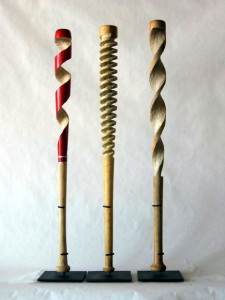
No…Cooperstown and the Dutch don’t care so much. The bats were simply bigger than pencils and smaller than logs. The whole thing started with carving sticks on my walks. I’ve made long walks in New Guinea, the Amazon, Burma, jungles, I like jungles. At the end of the day there’s not much to do and I started carving sticks while staring off somewhere. Sometimes in the morning I’d climb a tree, bore a hole and put the stick in it. They were about the size of pencils and when I got back to New York I’d carve pencils in front of the television. It was weeks before I left for Vancouver, and in New Guinea I didn’t have much to do. When I got to Vancouver I saw straight away logs and totem poles.
4. Your 2007 works at Nicole Klagsbrun rework some of the ideas we’ve long associated with your approach: A clean geometric graffiti over appropriated images – clowns, Vermeers, Van Goghs, printed landscapes… many of them Dutch, all of them “found.” The questions raised are many: Your geometric motifs seem inspired by common objects or shapes, while the works beneath your additions are historical in some cases, and simply those of forgotten artists in others. Do you feel you are adding to these works? How do you reconcile the aspect of vandalism? Are you re-painting history or making history paintings?
They are not appropriated images. They are appropriated paintings and drawings. There were two paintings in that show that I turned upside-down before I painted on them. I did that to remind you of exactly this fact: appropriated paintings, not images. And yes of course I’m adding to them. That is simple math. Whether or not it’s vandalism is not yes or no. I hope there’s enough vandalism to make just a little bite. Not a vicious bite. They are definitely motivated by affection, but not always by respect.
5. Your connection to Ray Johnson is a strong one, and one that we both share. You appeared in How To Draw A Bunny and described your relationship with Ray. In one memorable scene you explained how the visual and actual collide with language as a glass jar of instant coffee smashes on the street: “Coffee break,” you said in detailing Ray’s infinite play of language and life. Can you talk about how you met Ray and how he’s influenced you, if at all?
You know, this is a very embarrassing story. I have many memories of Ray coming up with shit like that but that particular example, the one about the coffee break, it was actually Mike O’Connell who said it. Mike was also a friend of Ray’s and it figures that I’d confuse them. I’m pretty sure Ray influenced me. Maybe some of the recent drawings are examples of that. But in other ways too, I mean, how does anyone you love influence you. Right? I think my songs often use a language I learned from Ray.
6. Have the Dutch masters in anyway taken you and your work in unusual directions. If not the artists from Holland, then perhaps the streets of Amsterdam – any thoughts there? Or even riding bicycles everywhere?
No not really. I just like living here. I really love Rembrandt, especially his etchings. I like them for the same reason that I like living here.
7. You told me during my visit at your studio that you were no longer interested in art. But I assume you are still interested in artists. Can you talk about the artists you admire?
I did not say I was not interested. I said I didn’t much like it.
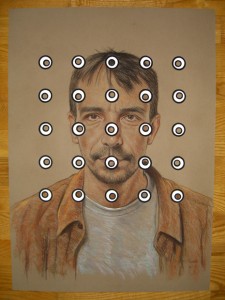
8. I noticed a giant screen in your studio. It is immense – perhaps 20 feet long – covered in gold leaf and dotted with various geometric motifs, your signature marks. What’s the genesis of this work? Was it a commission?
Yes a local guy commissioned it. He’s asked a number of artists to make screens for him. He’s an interesting guy. On New Year’s Eve 2008 I watched his house burn down. It was just down the street. It was incredible; it took only seconds for it to burn down. I’ve never seen anything like it! I suppose the screens are for the house he’s building himself now.
9. Since you’ve left New York, you’ve embarked on a musical career, launching The Woodwards, and when we met in Amsterdam in May, you’d just returned from a live performance on national Dutch radio. Now there are videos on You Tube and live performances nearly every week. Talk a bit about the music, the words and the videos, particularly the very moving song and video: “I Wanna Woman.”
Yes, that’s pretty funny. When I left New York for Vancouver I met some musical people and I started playing a bit of guitar. Then I discovered I had a knack for music, and started writing and singing songs. Then here in Holland I was sort of discovered by Attie Bauw. Attie is a legendary producer. He’s produced a lot of great records by all sorts of acts from Boots Collins to Judas Priest. He’s won Grammies. Anyways, he put me together with some great musicians (especially Rob Kloet from the Nits) and recorded an album of 15 songs. It’s really good. Different and good. Meanwhile, I’ve got great management behind me and The Woodwards are doing very well.
It’s a mid-life wet dream and I’m having a ball! “I Wanna Woman” is the single from the album. Tycho van Zijderfeld directed the beautiful video for it. We are rehearsing now for a big show in the Vondelpark in July. I’ll perform that show with Rob on drums (although it’s almost too unusual to simply call it drums) and three women singing backing vocals. And we have started charting out the second album. Attie Bauw will produce that as well. Everything by and about The Woodwards is at www.thewoodwards.nl – especially on the blog. There’s television footage from a Paradiso show, and Tycho’s clip, and also all sorts of odds and ends and amusements.
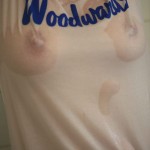
10. Are you in Amsterdam for good? What’s next?
Yes, it’s my permanent home. No question. The next thing is more Woodwards.
Matthew Rose is an American artist and writer based in Paris, France. His current project is organizing the worldwide, open artist call A BOOK ABOUT DEATH, set to open at The Emily Harvey Foundation Gallery in NYC, NY on September 10, 2009.


